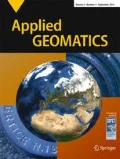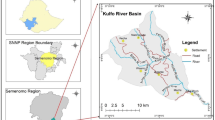Abstract
In this study, a part of Yamuna and Ken basin was selected for quantitative estimation of morphometric parameters through open access earth observation datasets. Further, spectral indices, namely Normalized Difference Vegetation Index (NDVI), Soil Adjusted Vegetation Index (SAVI), Normalized Difference Water Index (NDWI), and Soil Brightness Index (SBI), have been calculated to know the relationship with the morphometric parameters. The area has sub-dendritic to dendritic drainage pattern and designated as fifth order stream and drainage density (0.564 km/km2). The stream order is mainly controlled by physiographic and lithological conditions of the area. Spectral indices have been employed to understand the vegetation, wetness, and soil moisture and soil characteristics in the area. The water retention curves of the area have been developed. The spectral indices and morphometric parameters (Dd) shows highly positive correlation. The result has been validated with the aid of borehole/lithology datasets. These quantitative estimates will help in achieving and developing long-term strategies for combating hydrological drought, meteorological drought, climate-related drought, agricultural drought, water mismanagement-related drought, and affected region for preparation of suitable groundwater management plans.













Similar content being viewed by others
References
Asfaw E, Suryabhagavan KV, Argaw M (2016) Soil salinity modeling and mapping using remote sensing and GIS: The case of Wonji sugar cane irrigation farm, Ethiopia. J Saudi Soc Agric Sci. https://doi.org/10.1016/j.jssas.2016.05.003
Adhikary PP, Chakraborty D, Kalra N, Sachdev C, Patra A, Kumar S, Tomar R, Chandna P, Raghav D, Agrawal K (2008) Pedotransfer functions for predicting the hydraulic properties of Indian soils. Soil Research 46:476–484
Bali R, Agarwal KK, Ali SN, Rastogi SK, Krishna K (2012) Drainage morphometry of Himalayan Glacio-fluvial basin, India: hydrologic and neotectonic implications. Environ Earth Sci 66:1163–1174
Burrough PA (1986) Principles of geographical information systems for land resources assessment. Oxford Univ:193
Burrough PA, Rachael M. 1998. Principles of geographical information systems
Chopra R, Dhiman RD, Sharma P (2005) Morphometric analysis of sub-watersheds in Gurdaspur district, Punjab using remote sensing and GIS techniques. J Indian Soc Remote Sens 33:531–539
Choudhari PP, Nigam GK, Singh SK, Thakur S (2018) Morphometric based prioritization of watershed for groundwater potential of Mula river basin, Maharashtra, India. Geol Ecol Landscapes, DOI:https://doi.org/10.1080/24749508.2018.1452482
Dayal V, Sarup J (2015) Quantitative morphometric analysis of Bhadar River basin , India using ASTER ( GDEM ) Data and GIS 4:1204–1213
Samal DR, Gedam SS, Nagarajan R (2015) GIS based drainage morphometry and its influence on hydrology in parts of Western Ghats region, Maharashtra, India. Vol. 30, No. 7, 755–778
Esper Angillieri MY (2008) Morphometric analysis of Colanguil river basin and flash flood hazard, San Juan, Argentina. Environ Geol 55:107–111
Gao BC (1996) NDWI-A normalized difference water index for remote sensing of vegetation liquid water from space. Remote Sens Environ 58:257–266
Gayen S, Bhunia GS, Shi PK (2013) Morphometric analysis of Kangshabati-Darkeswar interfluves area in West Bengal, India using ASTER DEM and GIS techniques. J Geol Geosci 2:1–10
Gottschalk LC (1964) Reservoir sedimentation in handbook of applied hydrology. McGraw Hill Book Company, New York, pp 7–1
Grohmann CH (2004) Morphometric analysis in geographic information systems: applications of free software GRASS and R. Comput Geosci 30:1055–1067
Gu Y, Brown JF, Verdin JP, Wardlow B (2007) A five-year analysis of MODIS NDVI and NDWI for grassland drought assessment over the central Great Plains of the United States. Geophys Res Lett 34:1–6
Hadley R, Schumm S (1961) Sediment sources and drainage basin characteristics in upper Cheyenne river basin. US Geol Surv Water-supply Pap 1531:198
Horton RE (1932) Drainage-basin characteristics. Trans Am Geophys Union 13:350–361
Horton RE (1945) Erosion development of streams and their drainage gasisns; hydrophisical approach to quantitative morphology. Geol Soc Am Bull 56:275–370
Kauth RJ, Thomas GS (1976) The tasselled cap - A graphic description of the spectral-temporal development of agricultural crops as seen by Landsat. Proc Symp Mach Process Remote Sensed Data, West Lafayette, Indiana, USA, 29 June-1 July 1976 41–51
Kumar A, Jayappa K, Deepika B (2011) Prioritization of sub-basins based on geomorphology and morphometricanalysis using remote sensing and geographic informationsystem (GIS) techniques. Geocarto Int. 26:569–592
Kumar N, Singh SK, Srivastava PK, Narsimlu B (2017) SWAT model calibration and uncertainty analysis for streamflow prediction of the tons River Basin, India, using sequential uncertainty fitting (SUFI-2) algorithm. Model Earth Syst Environ 3:1–13
Kumar N, Singh SK, Singh VG, Dzwairo B (2018) Investigation of impacts of land use/land cover change on water availability of tons River Basin, Madhya Pradesh, India. Model Earth Syst Environ. 4:295–310
Li S, Chen X (2014) A new bare-soil index for rapid mapping developing areas using landsat 8 data. Int Arch Photogramm Remote Sens Spat Inf Sci - ISPRS Arch 40:139–144
Magesh NS, Chandrasekar N, Soundranayagam JP (2011) Morphometric evaluation of Papanasam and Manimuthar watersheds, parts of western Ghats, Tirunelveli district, Tamil Nadu, India: a GIS approach. Environ Earth Sci 64(2):373–381
Mahadevaswamy G, Nagaraju D, Siddalingamurthy S, Lakshmamma MSL, Nagesh PC, Rao K (2011) Morphometric analysis of Nanjangud taluk, Mysore District, Karnataka, India, using GIS techniques. Int J Geomat Geosci 1:179–187
McFeeters SK (1996) The use of the normalized difference water index (NDWI) in the delineation of open water features. Int J Remote Sens 17:1425–1432
Mesa LM (2006) Morphometric analysis of a subtropical Andean basin (Tucumán, Argentina). Environ Geol 50:1235–1242
Meddens AJH, Hicke JA (2014) Spatial and temporal patterns of Landsat-based detection of tree mortality caused by a mountain pine beetle outbreak in Colorado, USA. For Ecol Manag 322:78–88
Miller VC (1953) A quantitative geomorphologic study of drainage basin characteristics in the Clinch Mountain area, Virginia and Tennessee, project NR 389042, tech report 3. Columbia University Department of Geology, ONR Geography Branch, New York
Moglen GE, Eltahir EA, Bras RL (1998) On the sensitivity of drainage density to climate change. Water Resour Res 34:855–862
Mustak S, Baghmar NK, Singh SK (2016) Correction of Atmospheric Haze of IRS-1C LISS-III Multispectral Satellite Imagery: An Empirical and Semi-Empirical Based Approach. Landsc Environ 10:63–74
Myneni RB, Hall FG, Sellers PJ (1995) The interpretation of spectral vegetation indexes. IEEE Trans Geosci Rem Sens 33:481–486
Narsimlu B, Gosain AK, Chahar BR, Singh SK, Srivastava PK (2015) SWAT model calibration and uncertainty analysis for streamflow prediction in the Kunwari River basin, India, using sequential uncertainty fitting. Environ Process 2:79–95
Nautiyal MD (1994) Morphometric analysis of a drainage basin, district Dehradun, Uttar Pradesh. J Indian Soc Remote Sens 22(4):251–261
Pirasteh S, Safari HO, Pradhan B, Attarzadeh I (2010) Litho morphotectonics analysis using Landsat ETM data and GIS techniques: Zagros Fold Belt (ZFB), SW Iran
Rai PK, Mohan K, Mishra S, Ahmad A, Mishra VN (2014) A GIS-based approach in drainage morphometric analysis of Kanhar River basin, India. Appl Water Sci 1–16
Rao N, Latha S, Kumar A, Krishna H, Engineering C (2010) Morphometric analysis of Gostani River basin in Andhra Pradesh state, India Using Spatial Information Technology. Int J Geomatics Geosci 1:179–187
Rawat KS, Singh SK (2018) Water Quality Indices and GIS-based evaluation of a decadal groundwater quality. Geol Ecol Landscapes, 1–12. https://doi.org/10.1080/24749508.2018.1452462
Rawat KS, Bala A, Singh SK, Pal RK (2017) Quantification of wheat crop evapotranspiration and mapping: a case study from Bhiwani District of Haryana, India. Agric Water Manag 187:200–209
Reddy GPO, Maji AK, Gajbhiye KS (2004) Drainage morphometry and its influence on landform characteristics in a basaltic terrain, Central India—a remote sensing and GIS approach. Int J Appl Earth Obs Geoinf 6:1–16
Romshoo SA, Bhat SA, Rashid I (2012) Geoinformatics for assessing the morphometric control on hydrological response at watershed scale in the upper Indus Basin. J Earth Syst Sci 121:659–686
Roy S, Sahu AS (2015) Quaternary tectonic control on channel morphology over sedimentary low land: a case study in the Ajay-Damodar interfluve of eastern India. Geosci Front 6(6):927–946
Schumm SA (1956) Evolution of drainage systems and slopes in badlands at Perth Amboy, New Jersey. Geol Soc Am Bull 67:597–646
Schumm SA (1963) Sinuosity of alluvial rivers in the Great Plains. Bull Geol Soc Am 74:1089–1100
Sethupathi AS, Lakshmi Narasimhan C, Vasanthamohan V, Mohan SP (2011) Prioritization of miniwatersheds based on morphometric analysis using remote sensing and GIS techniques in a draught prone Bargur—Mathur subwatersheds, Ponnaiyar River basin. India Int J Geomatics Geosci 2:403–414
Sharma L, Pandey PC, Nathawat MS (2012) Assessment of land consumption rate with urban dynamics change using geospatial techniques. J Land Use Sci 7:135–148
Simunek J, Sejna M, Van Genuchten MT. 1998. The HYDRUS-1D software package for simulating the one-dimensional movement of water, heat, and multiple solutes in variably-saturated media. Version2.0. IGWMC-TPS-70. Int. Ground Water Modeling Ctr., Colorado School of Mines, Golden
Simunek J, Van Genuchten MT, Sejna M. 2005. The HYDRUS-1D software package for simulating the one-dimensional movement of water, heat, and multiple solutes in variably-saturated media. Version3.0. HYDRUS Softw.Ser.1. Dep. of Environ. Sci., Univ. of California, Riverside
Singh SK, Srivastava PK, Pandey AC (2013) Fluoride contamination mapping of groundwater in Northern India integrated with geochemical indicators and GIS. Water Sci Technol Water Supply 13:1513–1523
Singh SK, Srivastava PK, Singh D, Han D, Gautam SK, Pandey AC (2015) Modeling groundwater quality over a humid subtropical region using numerical indices, earth observation datasets, and X-ray diffraction technique: a case study of Allahabad district, India. Environ Geochem Health 37:157–180
Singh SK, Srivastava PK, Szabó S, Petropoulos GP, Gupta M, Islam T (2017) Landscape transform and spatial metrics for mapping spatiotemporal land cover dynamics using earth observation data-sets. Geocarto Int. 32(2):113–127
Singh SK, Singh P, Gautam SK (2016) Appraisal of urban lake water quality through numerical index, multivariate statistics and earth observation data sets. Int J Environ Sci Technol 13:445–456
Smith KG (1950) Standards for grading texture of erosional topography. Am J Sci 248:655–668
Strahler AN (1957) Quantitative analysis of watershed geomorphology. Trans Am Geophys Union [Internet] 38:913–920
Strahler AN (1964) Quantitative geomorphology of drainage basins and channel networks. In: Chow VT (ed) Handbook of applied hydrology. McGraw Hill, New York, pp 39–76
Szabo G, Singh SK, Szabo S (2015) Slope angle and aspect as influencing factors on the accuracy of the SRTM and the ASTER GDEM databases. Phys Chem Earth, Parts A/B/C 83–84:137–145
Thakur JK, Thakur RK, Ramanathan AL, Kumar M, Singh SK (2011) Arsenic contamination of groundwater in Nepal—an overview. Water 3:1–20
Vittala SS, Govindiah S, Honne Gowda H (2004) Morphometric analysis of sub-watersheds in the pawagada area of Tumkur district, South India, using remote sensing and GIS techniques. J Indian Soc Remote Sens 32(4):351–362
Verstappen H. (1983) The applied geomorphology. In: International Institute for Aerial Survey and Earth Science (ITC). Enschede
Van Genuchten MT (1980) A closed-form equation for predicting the hydraulic conductivity of unsaturated soils. Soil Sci Soc Am J 44:892–898
Wosten J, Pachepsky YA, Rawls W (2001) Pedotransfer functions: bridging the gap between available basic soil data and missing soil hydraulic characteristics. J Hydrol 251:123–150
Wilson J. (2012) Morphometric Analysis of Major Sub- Morphometric Analysis of Major Sub- Watersheds in Aiyar & Karai Pottanar Basin, Central Tamil Nadu, India Using Remote Sensing & GIS Techniques 2:8–15
Yadav SK, Singh SK, Gupta M, Srivastava PK (2014) Morphometric analysis of upper tons basin from northern foreland of peninsular India using CARTOSAT satellite and GIS. Geocarto Int 1–20
Yadav SK, Dubey A, Szilard S, Singh SK (2016) Prioritisation of sub-watersheds based on earth observation data of agricultural dominated northern river basin of India. Geocarto Int 1–18
Zheng F-L (2006) Effect of vegetation changes on soil erosion on the loess plateau. Pedosphere 16:420–427
Zhou P, Luukkanen O, Tokola T, Nieminen J (2008) Effect of vegetation cover on soil erosion in a mountainous watershed. Catena 75:319–325 Web Source: http://www.cgwb.gov.in/District_Profile/UP/Banda.pdf
Acknowledgements
The authors thanks the Department of Science and Technology, New Delhi, India for providing the financial support Grant No. DST/NRDMS [118/015(G)] and Editor in Chief of the Journal.
Author information
Authors and Affiliations
Corresponding author
Rights and permissions
About this article
Cite this article
Kumar, N., Singh, S.K. & Pandey, H.K. Drainage morphometric analysis using open access earth observation datasets in a drought-affected part of Bundelkhand, India. Appl Geomat 10, 173–189 (2018). https://doi.org/10.1007/s12518-018-0218-2
Received:
Accepted:
Published:
Issue Date:
DOI: https://doi.org/10.1007/s12518-018-0218-2




